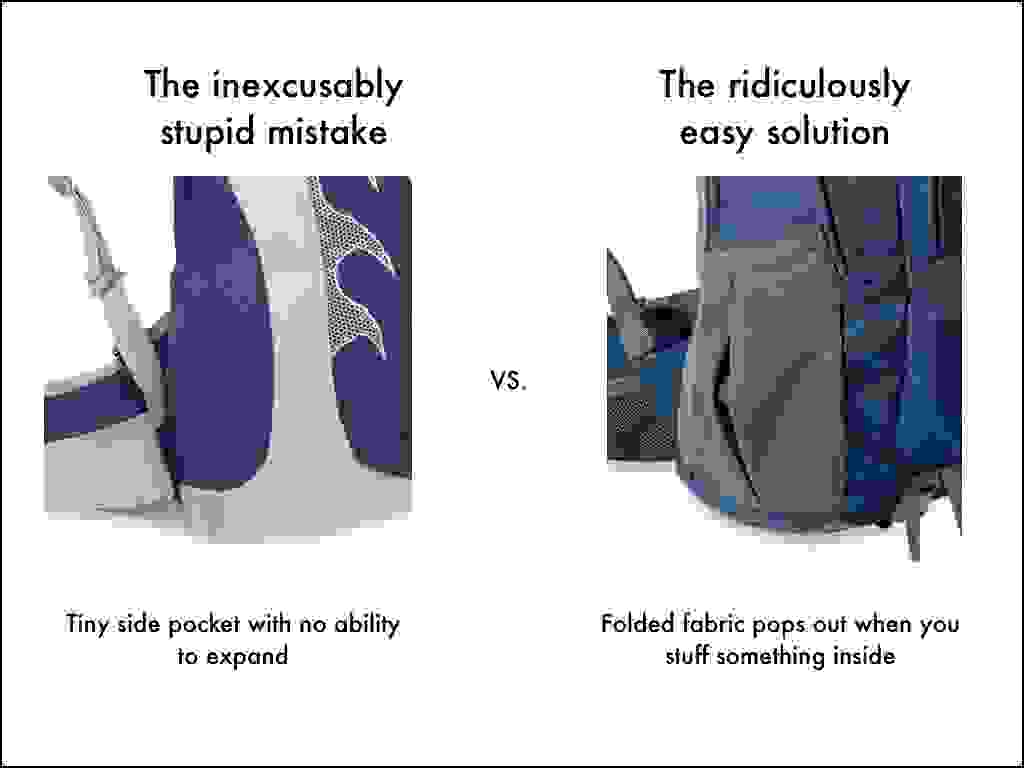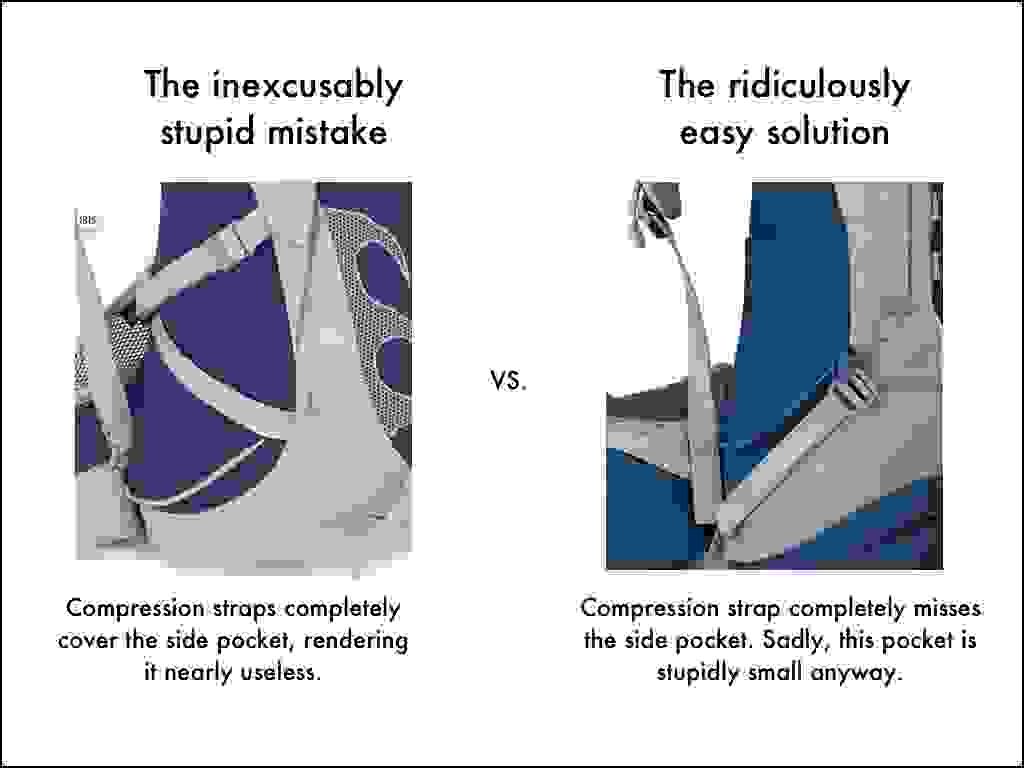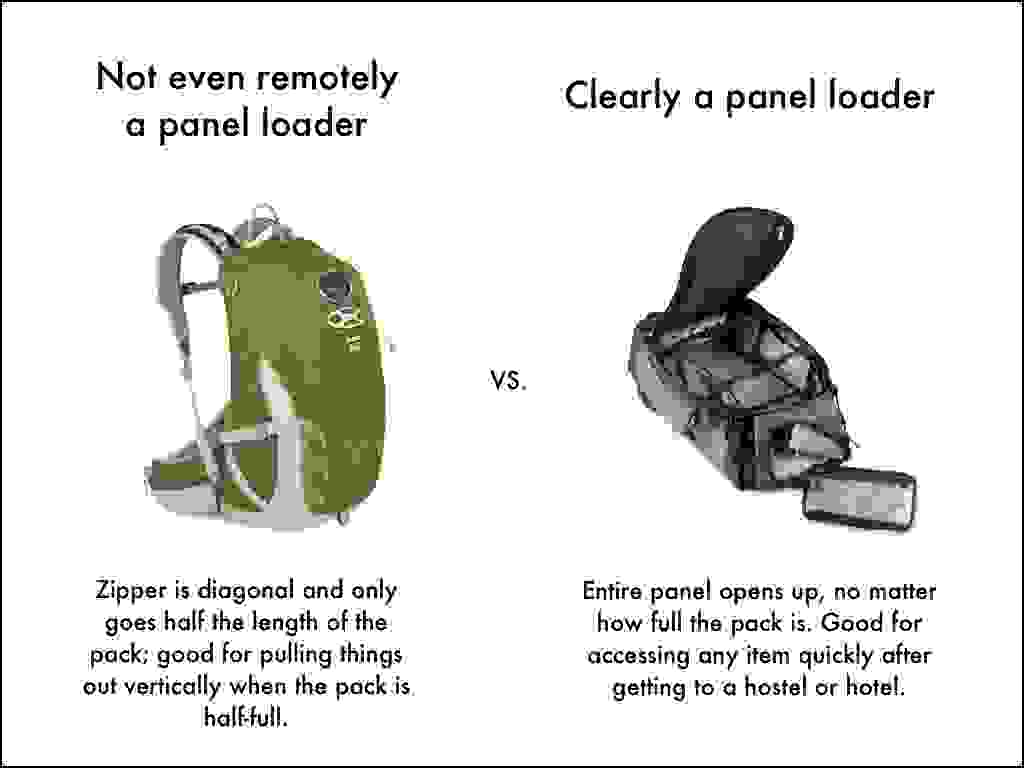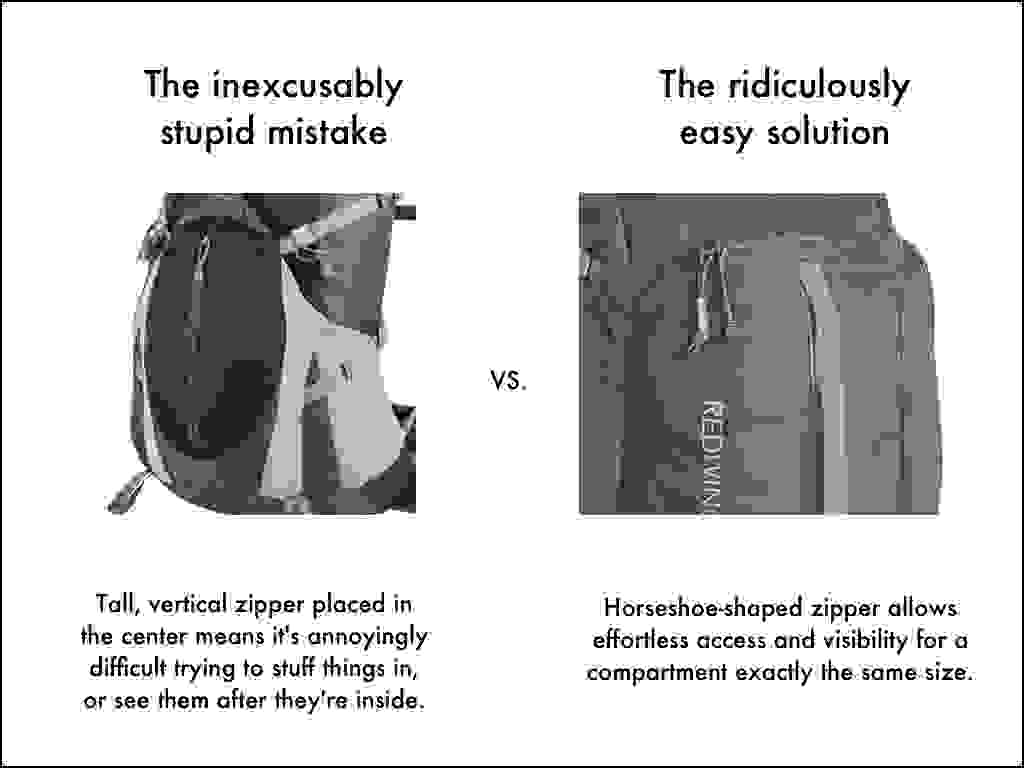As many of you may know, I am an endless complaining machine that cannot be satisfied even by the most magnificent of creations anywhere to be found. This debilitating curse manifests itself most thoroughly when it comes to high-tech travel gear, much of which is cartoonishly ruined by moronic designers who seem to have absolutely no idea that even the smallest of modifications could vastly improve their creations by several orders of magnitude.
I have no earthly idea how they’re able to screw things up so frequently, and many a strongly-worded-letter has departed from my desk, only to be cursorily answered or summarily ignored by the willfully foolish recipients whose job descriptions apparently do not include “making things not suck.”
So I’ll just complain here instead.

Backpack manufacturers make a massive variety of packs, churning out the designs every single year, with a billion different sizes, colors, configurations, and everything else. You’d think they’d provide enough variety to satiate the needs of even the most discerning of pack enthusiasts. But nay. Somehow they still manage to screw things up all over the place.
Now I’ll readily admit that in many cases, my subjective needs are not universally ideal; travel-specific packs require a somewhat different set of features compared to hiking packs, and the comparative rarity of travel packs means I quite often have to make do with a hiking pack, which is a bit like giving dog food to a crocodile. He’ll eat it, sure, but it’s still dumb.
But they’re not getting away so easily. Nay! I am here to complain, and complain I shall.
The following problems consist exclusively of design flaws that are not subjectively unsuitable for my purposes, but are just objectively stupid. They’re wrong. Plain and simple. And people need to stop doing them.
Let’s begin.
Backpack design flaws that need to stop immediately
1. Stupidly tiny “water bottle” pockets
I have absolutely no idea how this trend started. I think it has something to do with the popularity of hydration bladders, and backpack manufacturers figured that’s all they had to worry about. If everybody just has a hydration bladder, they won’t be storing a water bottle in a side pocket.
But not everybody has a hydration bladder. In fact I’d be willing to bet that more people have water bottles than hydration bladders, and they need a place to put them goddammit. Where the hell can they go besides the damn side pocket?!?! Not in the main compartment of the pack, surely. Not only is it a stupid hassle to take it out whenever you need a sip of water, but if there’s a leak of any kind, all of a sudden your day is ruined.
But I see backpacks all over the place…seemingly the majority of them…that have extraordinarily small side pockets with no ability to expand whatsoever. Which means they’ll be flat against the wall of the pack itself with a round water bottle trying to find its way inside! You’re literally stuck trying to fit a round object into a flat compartment. Do they even bother trying to fit any of those bottles that are sold in the same stores into the side pockets before shipping the product out the door?!?!
But they even issue promotional photos displaying a water bottle fitting into the pocket. Quite often the pack itself is only partially filled, meaning the water bottle dug into the empty space of the main compartment, meaning if the bag were full, you’d be out of luck.
And it’s not like they can’t handle solving this problem. It’s actually stupidly easy. All they have to do is:
- Use stretchy fabric
- Fold the fabric
In fact you only really need to do one or the other. In either case, the fabric will lay flat when the pocket is empty, and pop open when you stuff a water bottle inside. It’s literally that simple. And even if you don’t need to fit a water bottle in there, it’s still objectively superior anyway.
Behold:

I will never stop complaining about this, because it’s the most annoying thing in the world to me. I shouldn’t have to figure water bottle location into pack purchase decision making. They should just all be good.
2. Compression straps that cover the side pockets
So it’s one thing to make a side pocket so stupidly small that you can’t use it. But it’s another thing entirely to have a perfectly good pocket and lash something right over the top.
They’re called “compression” straps, and you have to pull them tightly to compress the pack. And you know what happens when you pull a strap tightly over a pocket? You can’t use the pocket anymore. You literally have to decide whether you’re going to use the pocket, or the strap, but not both. Or at least, not very well. The strap won’t be doing much in the way of compression if it’s loose enough to access the pocket itself, and thus is pointless.
The worst offense is when not one but two straps go right over the side pocket. On packs so small that they don’t need the double strap anyway!
In some cases, these straps can actually be routed behind the side pocket, so they won’t get in the way of things. But the fact that certain companies allow this option only on some of their packs is incredibly annoying. It’s also not even the best way to solve the problem.
Once again, a variety of solutions exist. Here’s the easiest one:

You can cut them off, but why don’t they just not do stupid things to begin with?!?!
3. Filthy dirty lie “panel” loading
This is mainly a vocabulary problem. Allow me to elaborate:
Backpacks come in a few varieties: Top loaders, which consist of giant cylindrical main compartments with a lid on the top; and panel loaders, which have a large, horseshoe-shaped zipper which allows the entire pack to be opened up like a suitcase.
Except when they fail to make the zipper go all the way to the bottom of the pack and you can only open it halfway. Plus, they’ll put the zipper in the middle of the pack, rather than at the edge, making it even more difficult to open completely.
Which means it’s not a panel goddammit. Check the damn dictionary!
Now I’ll admit that in some cases the half-panel loaders (that’s what I’m calling them) have their merits. School, for example. When you want to flip through a few books, all of which are balanced vertically, you’d want to open the pack from the top and flip through the options and take your pick. This works better than a full-length panel loader, which you’d sort of need to place flat on the ground to see what’s inside, and even then, you’d probably only be able to see one book at a time, unless you arranged them differently than anyone in the world ever has.
But it’s a terrible way to organize anything else. If you’ve ever had a sock at the bottom of the pack, you need to unload the whole damn thing to find it. And this is the weakness of half-panel loaders. They are by far the most difficult type to fill to capacity. And once you’ve packed them nearly full, it’s incredibly difficult to access anything at all.
It’s not to say they’re bad, but they’re horrible in certain cases. Travel, for example. And regardless, they certainly shouldn’t be called “panel” loaders.

Again, half-panel loaders have their merits, but when I say I want a panel loader, I mean a real one.
And there’s a very clever hybrid solution found in the Kelty Redwing, which combines top loading with panel loading into a single zipper. Unfortunately, it was one of the most horrifically uncomfortable things I’ve ever experienced.
4. “Bridge” shoulder strap

I have no idea who thought up this incredibly stupid idea. I bet it went something like this:
“Hey guys! Let’s change something that’s been working perfectly for decades!”
“Um, why?”
“Because fuck you, that’s why!”
I’m referring to the so-called “haul loop” found at the top of the pack. You can use it to pick up the bag, hang it on something, or whatever. And a few companies have started making bags where the haul loop is integrated into the shoulder straps, forming a bridge between them.
This is a terrible idea. I mean really awful. It means you cannot adjust the pack to fit high up on your back. You are required to carry it lower on your back than you otherwise could, meaning if you like wearing it up high, you’re stuck with something digging into the back of your neck all day.
I’m pretty sure the designers consisted of incredibly large people who wear their packs low and never bothered checking with anyone else.
Oh, and the haul loop is smaller and thus harder to grab, and it’s vertically positioned rather than horizontally, so it’ll dig into your fingers more. Hooray!

Seriously, how did no one say anything?
5. Centrally-placed vertical zipper
Okay, I know this one is kind of a reach, because it’s somewhat obscure. But it’s also dumb.
I’ve only seen this in a few places, and I think it’s supposed to be for maps, which are (usually) vertical pamphlets that can be slipped inside flat pockets with tall zippers. But tall, centrally-located vertical zippers are just incredibly stupid.
Firstly, it’s hard to put small things in there. It’s practically impossible seeing inside while trying to find them, and they might even fall out. And secondly, it’s also difficult putting large things in there. It seems like a decent place for a rain jacket, but the process consists of stuffing the jacket into the left half of the compartment, and then stuffing the rest into the right half. You literally cannot access the entire pocket all at once, because it’s just this tiny slit that’s somehow supposed to provide access to this massive pocket.
I had this sort of zipper on an old pack of mine, and I literally did not use the pocket. Ever. It just sat uselessly. It’s so difficult trying to take things in and out that I just didn’t bother anymore.

I really don’t get this one either. If you’re supposed to fit tall, flat papers into there, it would still work better to put the zipper literally anywhere else. Horizontally across the top, or vertically along the side. But, best of all, upside-down letter U. Done and done.
Backpack design error objective vs. subjective
Now I’ll readily admit that my particular needs may not be the same as those of someone else. But in the cases listed above, with the exception of the panel-loader vocabulary problem, the design choices are just objectively wrong. And, annoyingly, they are incredibly frequent. I really have no idea why they continue to exist.
I wonder if it’s simply that most people are more or less fine with a pack as long as it’s good, and they’ll live with the limitations as long as it holds up to serious use. I’d feel that way as well, but when I see design flaws, especially incredibly dumb ones, it just ruins my whole day.
A few more:
- Backpack manufacturers have apparently not realized that the load lifter straps (the small strap on top of the shoulder strap, that pulls the pack closer to your body) can be routed quite conveniently into hydration bladder port straps. Pretty much ever pack has a tiny strap, on the shoulder strap, where a hydration bladder hose is held in place. It’s also a great place to stick the load lifter straps so they don’t flail around annoyingly. The reason I think pack manufacturers haven’t realized this is that sometimes they’ll only put a strap on one side, instead of both.
- You know those hip stabilizer straps? Basically, it’s the small strap, on top of the hip strap, that pulls the pack closer to your body. It also forms a dangly thing that, if you have dual hip belt pockets with a slot where the dangly strap can go, can be kept out of the way. Once again, I don’t think pack manufacturers have quite realized this, because many of them give you only one hip belt pocket and the strap on the other side dangles annoyingly.
- When the base is rounded instead of flat, the pack falls over whenever you set it down. It’s incredibly annoying.
- If you have a top loader pack whose lid pocket attaches to a strap whose only connection point to the pack itself is at the very bottom of the pack, every time you unclip the buckle to open the pack, the strap will fall all the way to the ground. There could be something to prevent this, and it would be incredibly easy. I used dental floss. I’m sure they could do something a little more clever.
And you’ll notice that in many of the pictures shown above, the “bad” pack was an Osprey pack. And there’s a reason for that. Osprey make a million different packs, and plenty of people are happy with plenty of them, but…if I want to find a pack that’ll annoy the hell out of me, I know exactly where to go. Osprey is the absolute biggest culprit of tiny side pockets, and straps covering the side pocket anyway. Among other things.
I intend to continue complaining about these problems until I become such a thorn in the side of these companies that they are forced to acquiesce to my demands. Wish me luck!




great list, another one I haven’t been able to figure out is why don’t all packs come with a strip of strong webbing loops directly on the very back of the pack. When backpacking I always use this to carry a pair of runners, crocs, or sandals. I want these hanging on the back of my bag on the outside. Imagine walking all day in a pair of runners, now they stink and they’re sweaty. I’ve probably stepped in dog shit or a cockroach at least once. Why would I then want to put them inside a shoe bag and inside my bag where they can start to ferment in a dark sealed environment?
Clicking them on a carabiner to the exterior of the bag ensures that they get aired out, and with the added bonus of nobody wanting to push you in line or get too close. And when you load your bag into the overhead compartment people also don’t jam their bag against yours and start slamming the door shut either.
I like your “keep random weirdos away from me with smelly shoes” strategy. I should try it sometime…
You’re a funny bastard! I’m glad I found your article. Thanks for putting so much thought into it. Your comments are very helpful, even to an old bastard like me who doesn’t think he needs any advice from anyone else about backpacks.
I do waver between the “it’s good enough” mentality and the “it could be perfect, so why isn’t it already?!” It’s not so much that I demand perfection, but that I demand the improvement of obviously-fixable problems, because those are the ones that annoy me the most. Happy to hear you enjoyed it, though!
Well, it was an informative post and you have explained well.
I think having a few routeing holes and points in the military backpack will support a lot while tracking your drinking tubes through them along with your radio antennas.
That way, you do not get mismanage through the entire bag looking for your water supply where you can append hydration tubes to your hydration packs.
Keep Posting!
Have you looked at the ULA camino? It’s from a weight conscious hiking company, but it’s a full panel loader.
That would certainly work. It looks quite outdoorsy, but some people are fine with that. I can’t quite see what the backrest looks like on the product page, but hopefully it’s something good.
My top complain with 99% of backpacks: no matter how many inside pockets you have, they are all open at the top, and when you fill them all, everything sits at the bottom of the backpack and the top is empty. Turn the back around once, and everything is everywhere.
Try Arcteryx leaf Khard or Assault pack then.
Nice looking backpack but Khard 60 Pack = C$629.00
http://leaf.arcteryx.com/product.aspx?country=ca&language=en&model=Khard-60-Pack
Thanks for sharing.
Eh, I don’t really fuss too much. I recently reached the point where I could probably go for weeks without much equipment at all. Real cro-magnon shit. I use this tiny backpack I acquired at Valhalla Pure. It can carry a change of clothes, some water, some food, and that’s mostly it. I don’t recall what it’s called, but it seems to follow your standards. It’s great, but I fear it’s a luxury!
Cheers, man.
Snarky, your one funny dude!
I’m on a volunteer wilderness K9 Search and Rescue team. We are required to carry a ton of gear and water (2-3L for person & 6L for our dog) that make the pack heavy. On average, I wear my pack about 14 hours a week, so comfort and functionality are a huge deal for me. I wore the MountainSmith Circuit 4400 for years. GREAT accessory and water bottle pockets, super heavy for it’s size.
Last year I decided to lighten my load and went searching for a new pack. Most of my teammates wear the Gregory Diva and love it. I wanted to love it but it didn’t fit me well so I settled on the 2016 Osprey Ariel 55 instead. It’s the most comfortable pack I’ve ever owned. But, while comfortable, it has several design flaws that are so obvious I’m amazed they didn’t see them during the testing phase.
1. They “fixed” your water bottle pocket gripe. The compression straps can now be routed behind the bottle and the pockets are stretchy enough to fit my 34 oz Avex water bottles. Yay…..wrong!! The pockets are 14″ long and run vertically along the pack, making it impossible to get the bottles out of, or back into, while wearing the pack.
2. This pack is a panel and top load. I thought this was a cool idea at first. It’s really just a major pain in the ass pocket to get into. You have to un-clip three connection points before you can unzip the compartment, and then flap only opens to the left (C-shape) part way.
3. You mentioned that your a fan of the exterior hydration pocket? Well, that is another useless pain in the ass pocket. I went through three brands and shapes of bladders before finding one that kinda works for this pocket. Why you ask? The pocket is not very long and very tight to get into when the pack is empty and nearly impossible, when the pack is full. Once the 3L bladder into the full pack it totally misshapes the back of the pack, making it uncomfortable to wear.
4. The hip belt pockets are so small they’re nearly useless. I’d rather not have them and be able to attach my own than have these. Pack companies should delete this useless feature and offer attachable accessory hip belt pockets, in various sizes, that compliment the pack.
My ideal pack would be 40L size of military design. It would be lightweight, have attachment points for multiple accessory pockets, have canted secure water bottle packets large enough to hold a Liter each and an interior badder pocket. Most importantly, it would have a hefty hip belt to take the heavy load off of my shoulders.
Oh well, one can dream :)
Keep up the good fight!!
Take a look at the Deuter ACT Trail Pro series. It might not be quite what you’re looking for (the side pockets aren’t easily accessible while wearing the pack), but I love how the straps are situated out of the way of any side pocket, and you don’t need to undo too many to get into the pack. And it has a panel loading design in addition to the top loading option, and it’s a pretty big panel. I think it looks pretty great.
Nice article, I agree these are pretty annoying and stupidly obvious design flaws.
But you left out the #1 most annoying, terrible, infuriatingly idiotic design flaw that is unfortunately ubiquitous to the point where it is damn near impossible to find a pack without this problem: Mesh on the shoulder straps and (to a lesser extent) the back panel.
There are several problems with this:
– The mesh digs into your skin. Whereas with a smooth fabric, the weight is distributed evenly under all the surface area of the straps, with mesh the weight is concentrated in a much smaller area, under the ridges of the mesh. This is the worst possible material to use on the underside of shoulder straps. Most of the time it’s not that noticeable, but after very long hikes or with a lot of weight, I am often left with serious irritation and marks in the pattern of mesh on my shoulders that last for several days. And I don’t have sensitive skin
– Debris gets stuck to and embedded in the mesh, and is very difficult to remove. for example small pine needles. If you spend much time outdoors, depending on the environment and season, there is a lot of debris that can get permanently embedded in the straps and back panel. Unless you are meticulously careful about where and how you set your pack down on the ground, and spend a lot of time immediately removing any debris that gets snagged, Before long lots of debris will work it’s way into the mesh, making it even more irritating.
– The mesh is supposed to make it more breathable, but does not. It’s a ridiculous idea- regardless of the material against your skin, shoulder straps consist of a thick layer of high density foam, and tightly woven nylon on the top. No air is getting through that, and sweat cannot evaporate through the shoulder straps. At best the mesh allows the foam to act as a sponge for sweat, but it does that anyway with solid fabric. Besides personally I’d rather more of the sweat stay at the surface of the strap, where it can quickly dry off and be rinsed off, than get deeply embedded in the foam, making the pack smell or degrade faster.. Bottom line, shoulder straps don’t breath, with or without mesh, so there is no upside.
I’ve found that there are different kinds of mesh generally used: ‘Hard’ mesh that is stiff, net like with large holes, and very noticeable texture- this material is more durable, but digs into your skin a lot more. Soft / flat mesh- I’ve noticed this much more recently, and it feels much better and less abrasive, this is more like a very thin fabric with smaller holes. This stuff feels better, but snags and tears far more easily
I am seriously perplexed why why more people don’t seem aware of or bothered by this. I can only guess that it’s so ubiquitous today, that most people have never seen a pack without it, and don’t know that there’s a better way. I have some older packs that have a solid, smooth, and soft material for the shoulder straps and back panel, and it feel so much better, never causes skin irritation, and the material is far more durable and doesn’t snag debris.
There are other uses of mesh, pockets for example, where it is debatable whether the benefits of lightweight or stretchiness or worth the lower durability, but there is no reason any shoulder straps should have mesh. Or back panels, unless we’re talking a system like some Osprey packs that are actually ventilated with open air behind the mesh.
I actually haven’t used packs in the woods extensively enough for debris to get stuck in them for me, so this is kind of new to me as well. But I do see the problem. I’ve seen some backpacks that are meshy on both sides, without the fabric on the top side, but then they can get debris in there too. Tom Bihn has solid fabric covering the straps on both sides. Peak Design has a very fine mesh on the skin side, so it’s probably not so irritating. Those aren’t hiking packs though, so I’m not sure if there’s something good for the outdoorsy types.
amen. took the words right out of my mouth. spent half a day at REI and each bag has one stupid item that makes it unusable.
I’m eyeing the Deuter ACT Trail Pro series quite a bit. Every single one of the straps goes in a direction that doesn’t get in the way of anything else. Top loading and panel loading, and a really simple layout. Comfy, too. At least for me.
Haha, I love this post! I first found it a few months ago, and it has subsequently come up on Google so many times when searching for stupid design flaws in backpacks for the past few months (I always come to the conclusion that my 4-year old trusty work horse, a cheap Graviti 35L, is good enough… but horrific to look at).
One thing I can not for the life of me understand, is why bags that are supposedly designed for city/urban/commuter use need those freakin’ ugly and annoying compression straps! Make the darn thing expandable by slapping on one of those expansion-zippers that go all the way around the bag – looks way cleaner, no annoying straps hindering access to the water bottle pouch or getting caught in stuff. And if they absolutely freakin’ need the straps – put them on the inside of the bag. They look unsightly and ridiculous on anything but a large 50+ liter hiking pack. I have never in my entire life had any use for the darn things, not even on my 70 liter hiking pack, and much less so on any of my smaller daypacks – I actually ended up cutting them off some of my packs!
Yeah, I never use them either. In a huge pack they’re useful, if you have a pack that’s half full, but if it’s 25 liters or less, it’s not so important. Maybe one on each side can be fine at that size.
Take a look at the Deuter ACT Trail Pro. All its compression straps are channeled out of the way completely. Very clean and nice to use.
I personally think compression straps are a critical feature, and a lack of them on anything but the smallest, minimalist daypacks (say ultralight packs below 20 liters) to be a serious design flaw. There are some very specific cases where the design or function of a pack makes them unnecessary, but most of the time this is not the case imo. However they are also one of the most under-utilized features, even many hikers and backpackers often don’t understand how to use them properly. One annoying trend is large packs having only one side compression strap when there should be two, or combing them and/or merging them with front compression straps. Also using excessively narrow or flimsy materials for these straps and their buckles.
In addition to the primary function of compression straps (stabilizing the load and pulling it closer to your back for better balance and comfort), they are also very useful for attaching all sorts of items to the outside of the pack.
But as you pointed out, if you don’t like them there is a very easy fix- just cut them off!